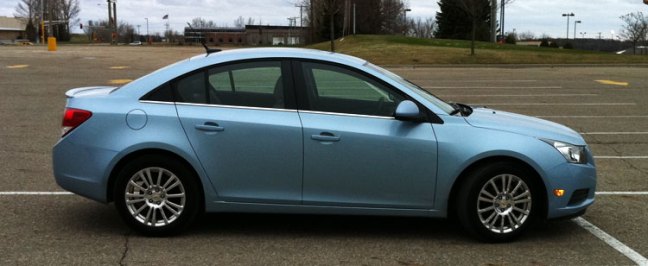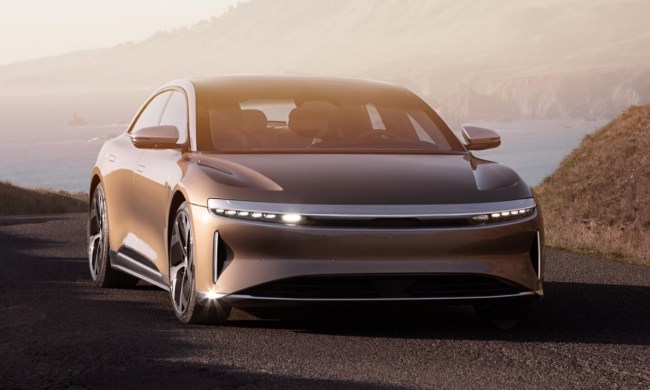
For the doom-and-gloom folks out there, yes – it is distinctly possible that fuel prices could soar about $6 per gallon this year. In Europe, filling your tank is usually more expensive than feeding your family for a week. And, according to some economists, recent turmoil overseas, including the Bin Laden takedown and the Japanese nuclear disaster, are creating a volatile market for oil prices.
For some, the ultimate answer is to ditch the internal combustion engine and go electric. Interestingly, there are also some very vocal EV opponents, mostly because of the high replacement costs, the shifting burden (when you buy an EV you add your existing gas-powered car to the used market), and how the infrastructure is nowhere near done.
One short-term answer is to improve the efficiency of the gas engine, and that’s exactly what Chevy has done with the 2011 Cruze Eco. Rated at 42MPG for highway driving, the car is not a cramped “smart car” like the Smart Fortwo, which lasts for eons on one tank but drives like a Segway.
Livable and economical
Instead, the Cruze Eco is a fun small car that costs $16,525. Because of the smaller size – similar to the Ford Focus or the Honda Civic – you can zip around, fit easily into parking spots, and accelerate by down-shifting with the manual transmission.
We tested the bare-bones Eco in Chicago traffic. Some of the impressive features include a 250-watt, nine-speaker stereo that sounded distinct and powerful enough, although it is no match for a premium sound system from, say, Rockford Fosgate.
Like the Ford Focus, the Cruze Eco has some surprising technology features that you might expect to find only in a full-size sedan. There’s a USB port for your iPod Touch or iPhone, Bluetooth phone capability with buttons on the steering wheel, and cruise control. The Eco even lets you call OnStar for navigation routes, which appears on a text-only display and in the dash, but only for the specific turns. There is no touchscreen for displaying a map or points-of-interest.
The Eco is about the size of a VW Jetta or a Lexus IS 350. Seating is a bit cramped, both for the driver and passengers. Trunk space is adequate, but we’re not in the same league as a Kia Optima or a Hyundai Sonata in terms of a wide stance. You will feel as though the front passenger is sitting dangerously close to your elbow.
We wanted to find out how the vehicle performed on a long drive. We already tested a Cruze LTZ model with an automatic and a more luxurious interior. The Eco has a more staid interior and a stick shift – it’s meant for economical driving. We drove about 600 miles from suburban Chicago all the way to Fargo to see if we could last on one tank of gas. The results were impressive, and a bit surprising.
Improving fuel economy
First, we should mention that Chevrolet worked hard to achieve the 42MPG rating. Every slight technical advancement sneaks out a bit more fuel economy. Engineers designed a low front grille to improve airflow, the aluminum wheels are lighter than normal, and the Cruze Eco even uses low-resistance tires.

The rack-mounted power steering also helps the car sip less fuel compared to hydraulic power steering. In driving the Eco, you quickly realize that the 1.4-liter engine is punchy in low gears, but not that fast for acceleration. In fact, comparing the Eco to the 2011 Suzuki Kizashi SLS that also has a manual transmission, there’s a sense that the Eco is under-powered. You can’t stay in first or second gear very long compared to the Kizashi, which means you’ll need to think more about shifting right away every time you pull away from a stoplight.
Another important note to make about fuel economy is that we’re not in the same category as smaller, lighter vehicles like the Toyota Prius, which can go up to about 51 miles per gallon even for city driving. The Cruze Eco we tested reported an average fuel economy of only 17MPG when we first started driving, since the previous testing was obviously conducted in Chicago.
Putting it to the test
What we did find is that the Cruze Eco responds extremely well to some fairly simple changes in how you drive. Now, there are some “hypermiler” techniques that we don’t recommend because they tend to be a bit unsafe: You can draft behind trucks, or even turn off the engine on a hill descent. A better approach is just to watch traffic carefully. Because of some basic physics principles about inertia (it takes more energy to keep the car going at a faster speed), the best tip is to just drive slower. We tended to stick right around 65MPH on our Chevy Cruze Eco test.
Another tip is to avoid braking as much as possible. If you see traffic up ahead, it is better to coast to slow the vehicle than to brake. We also used the cruise control frequently to lower our speed slightly and then to gradually speed up again. In some stretches, we attained about 52MPG on average. Yet, we also hit some heavy traffic in Minneapolis and played the stop-start game for a few miles.

Our average for the entire trip turned out to be 43MPG, which is a bit surprising since it almost matched the EPA estimate. We could have achieved a higher MPG by driving slower and braking even less. We also tended to shift down occasionally as a way to slow the vehicle in congested areas – it would have been better to stay more vigilant and coast more often to improve fuel economy.
The unfortunate final result, though, is that we did not achieve the ultimate goal. About 100 miles from Fargo, the fuel range indicator reported 50 miles. We could have tried more hypermiler techniques and risked running out of fuel, but instead decided to add a few more gallons to the tank.
Our average speed ended up being 62.4MPH for the entire 600 mile journey. Our fuel economy for the trip was exactly 43.4MPG. As you drive, you can see the instant fuel economy rating, and we frequently saw a range of 55 to 65MPG and even up to 99MPG. At the time we had to add some fuel, we had driven exactly 447.2 miles and had a range of 49 miles left (for the 500 total), and had used 10.6 gallons of gas.
Still, when most sedans barely run for 400 miles on one fill, the fact that the Eco lasted for about 500 miles is impressive. We were not driving in a luxury sedan – the Eco is a bit small for long highway driving. Yet, the Cruze Eco lived up to its name and provided an economical, and occasionally sporty, drive.



